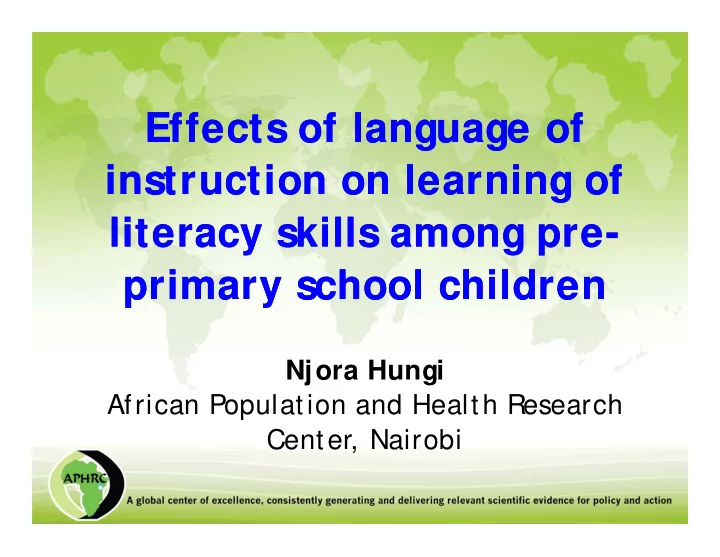

Effects of language of Effects of language of instruction on learning of instruction on learning of literacy skills among pre- literacy skills among pre- primary school children primary school children Njora Hungi African Population and Health Research Center, Nairobi
Outline Outline Introduction Method Obj ectives Analyses Literature Results ECDE LoI policy Potential implications
Introduction Introduction Objective To investigate the relationship between the language of instruction and literacy achievement in a multilingual environment In a multilingual environment, is there an advantage in learning literacy skills using a second language (in this case Kiswahili) over a third language (English)?
Introduction Introduction Literature Y oung children learn better when taught in their first language or mother tongue, MT ( e.g. Begi 2014; Khan 2014; Piper et al., 2016 ) Mastering of MT promotes the acquisition of a second language (Pflepsen, 2011) Children who understand MT are more likely to enter the school system at the correct age, attend school regularly and stay in school (S mits et al. 2008; Thomas and Collier 2002) Use of MT also associate with improved learning outcomes, lower grade repetition rates and improved self-confidence (UNES CO, 2011)
Introduction Introduction ECDE policy on language of instruction • The Kenyan ECDE policy specifies that children below 8 years of age should be taught using the language of the catchment area (mother tongue), or using Kiswahili if they are attending schools located in multi-ethnic areas (Republic of Kenya 2006, 2012) • However, this policy is rarely reinforced by the education authorities, nor is it followed by many early childhood education providers • Thus, common to find preschools using English in non- English speaking areas
Method Method Setting of the study: Urban informal settlements in Nairobi Target population : PP2 learners attending APBET schools in January/ February 2016 Sampling design : Randomized control trial Sample size : 1867 PP2 pupils attending 147 APBET schools; 48.4% taught in Kiswahili and 51.6% in English
Method Method Direct assessment : • Adapted from the UNICEF/ UNES CO school readiness tool (known as Monitoring Early Learning, Quality and Outcomes, or MELQO) • Two versions of the test – English and Kiswahili • Literacy skills assessed included letter identification, letter sounds, initial sound identification, rhymes, and listening • 10-15 minute one-on-one session with each learner • Learner scores on a Rasch scale; mean = 300, stdev =100
Analyses Analyses Two-level multilevel model Level 2 (School) Level-1 (Learner) Language of instruction Pupil sex Classroom resources Class size Pre-service training In-service training Teaching experience Teacher guide Teaching documents Textbooks
School-level Pre-service In-service Year of Teacher’s (Level-2) training training experience Guide Teacher’s Class size Guide Classroom resources Textbooks Language of instruction Learner-level (Level-1) Learner Learner sex Score
Results Results - Descriptive - Descriptive - Multilevel - Multilevel
Differences in literacy scores – KvsE Differences in literacy scores – KvsE Learners taught using in Kiswahili did better
Differences in literacy scores – KvsE Differences in literacy scores – KvsE Perhaps this implies that there is limited advantage of using Kiswahili to teach if the learners do not have textbooks
Differences in literacy scores – KvsE Differences in literacy scores – KvsE Results could be unstable because of small numbers of learners; K=56, E=58
Differences in literacy scores – KvsE Differences in literacy scores – KvsE Learners taught using in Kiswahili did better regardless of possession of teaching documents
Multilevel analysis Multilevel analysis Coefficient SE P-value Grand mean 277.97 7.62 0.000010 Level-2 Language of instruction is Kiswahili 20.05 9.01 0.027717 ** Classroom resources 2.68 4.41 0.544194 Class size 0.09 0.35 0.799876 Teacher pre-service qualification 7.35 10.80 0.497652 Teacher in-service training 37.15 22.90 0.106888 Teacher years of teaching ECDE 1.63 0.80 0.043984 ** Teacher has teacher's guide 2.89 12.32 0.814560 Teaching has teaching documents 18.66 9.09 0.042074 ** Textbook-learner ratio 6.39 10.98 0.562195 Level-1 Learner sex (0=Boy; 1=Girl) 7.85 3.66 0.032243 ** Learners taught using in Kiswahili outperformed those taught using English by about 0.20 S D units.
So what … So what … Teach ECDE learners in low resource environment (such as in APBET schools) in a language they are familiar with – in this case Kiswahili Encourage compliance to the current policy on LoI campaign should target Preschool education providers Parents Primary schools
Children’s Investment Fund Foundation Children’s Investment Fund Foundation + Study Participants + Study Participants
nhungi@aphrc.org Njora Hungi
Recommend
More recommend